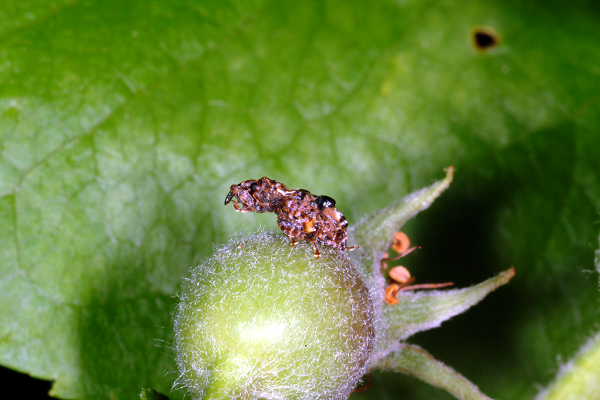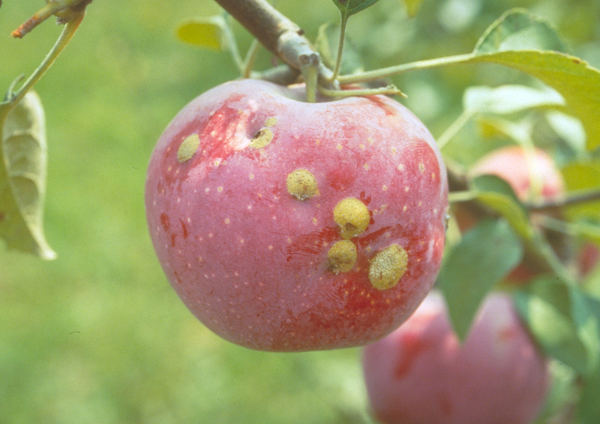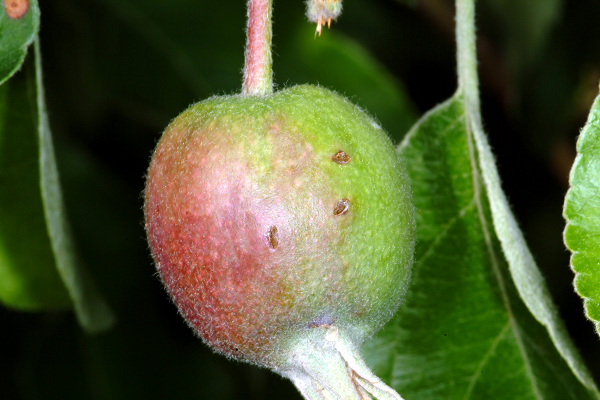Plum Curculio
ENTFACT-202: Plum Curculio | Download PDF
by Ric Bessin, Extension Specialist
University of Kentucky College of Agriculture
Plum curculio is a native pest of North America that can cause considerable problems in orchards throughout Kentucky. While it has only a single generation in Kentucky, it can cause serious early-season fruit damage to apple, pears, peaches and other stone fruits.
Life History
The adult is a typical snout beetle, 1/4 inch long, dark brown in color with patches of white or gray. There are four prominent humps on the wing covers. The snout is 1/4 the length of the body, with mouth parts located at the end. Plum curculio overwinters in the adult stage in ground litter or soil usually outside the orchard. Adults migrate into the orchards each spring. Often border rows near woods are the first to show injury.

Figure 1. Adult plum curculio on young apple
The adult curculio becomes active in the early spring where it flies to trees and feeds on buds, flowers and newly set fruit over a five to six week period. This results in cat-facing facing of the fruit because of plum curculio feeding and egg-laying injuries. The female adult cuts a hole in the fruit with her mouthparts and hollows out a small cavity then turns and deposits an egg in the cavity. She then cuts a crescent-shaped silt which extends beneath the egg so as to leave the egg in a flap of flesh. Injury will appear as a 1/8 inch crescent-shaped cut on the fruit. This prevents the egg from being crushed by the rapidly developing fruit. After about five days, the larvae will hatch and burrow into the fruit. The larva is a legless grayish white grub with a brown head. Its length will be about 1/3 inch when full grown.
When the larvae are fully developed, they will leave the fruit through clean exit holes. No frass or webbing will be evident. Frass is usually found around the calyx end on codling moth damaged fruit.

Figure 2. Late season fruit scarring by plum curculio
Surface feeding and egg-laying by the overwintering adults can scar or misshape the fruit by harvest, while feeding by the larvae causes premature drop of the fruit. In peaches, gummy material can often be seen at the location of the wound. These insects are active primarily at night and serious damage may appear in orchards that have been scouted rigorously even though the adults were not detected. Currently there are no methods to accurately predict when damage will occur.
Emerging adults in the late summer feed on apples for a short period of time. They cause round, cylindrical feeding wounds in the side of the fruit that penetrate about 1/4 inch that often lead to rots on the fruits.
Control
Adults control is accomplished by insecticide applications timed at the petal-fall and/or first-cover stage for apples, and the shuck-split and first-cover stages in peaches and cherries. Serious plum curculio damage is usually restricted to orchards that do not use an insecticide application that is effective against plum curculio in this period. To improve timing, commercial growers can use a beat sheet to monitor for the adults, or monitor for the first signs of curculio damage to the fruit. Generally, the adults begin to damage the fruit when the night time low temperatures begin to reach 60°F.

Figure 3. Fresh egg-laying wounds to young fruit.
Home gardeners can help reduce future problems by picking up these damaged apples as they fall off the tree and destroying them before the adults emerge. In apples, the larvae will only complete development in fruit drops.
For more information on reduced insecticide apple management programs, see ENTFACT-201, Controlling Apple Insect Pests with Reduced Insecticide Usage.
Revised: 11/19
CAUTION! Pesticide recommendations in this publication are registered for use in Kentucky, USA ONLY! The use of some products may not be legal in your state or country. Please check with your local county agent or regulatory official before using any pesticide mentioned in this publication.
Of course, ALWAYS READ AND FOLLOW LABEL DIRECTIONS FOR SAFE USE OF ANY PESTICIDE!
Photos courtesy Ric Bessin, University of Kentucky Entomology
